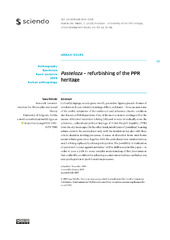Pasteloza - Refurbishing of the PPR heritage
Чланак у часопису (Објављена верзија)
Метаподаци
Приказ свих података о документуАпстракт
Colourful zigzags, arcade game motifs, geometric figures, pseudo-frames of windows and even infantile drawings of flora and fauna – those are just some of the visible symptoms of the aesthetical and urbanistic chaotic condition also known as Polish pasteloza. One of the most common readings is that the excuse of thermal insulation is being (ab)used in order to radically erase the urbanistic, cultural and political heritage of Polish People’s Republic (PPR) from the city landscape. On the other hand, inhabitants of ‘pastelized’ housing estates claim to be satisfied not only with the insulation but also with their role in decision-making processes. A sense of alienation from one’s home seems to have gone away, together with the centralized state administration, and it is being replaced by citizen participation. The possibility of vindication of pasteloza’s ‘crimes against aesthetics’ will be deliberated in this paper – in order to pave a path for more complex understanding of this phenom...enon that could offer a solution for achieving a compromise between aesthetics and civic participation in post-transition processes.
Кључне речи:
ethnography / pasteloza / post-socialism / PPR / urban anthropologyИзвор:
Urban Development Issues, 2019, 63, 51-64Издавач:
- Warszawa: Institute of Urban and Regional Development
Колекције
Институција/група
IFDTTY - JOUR AU - Nikolić, Sara PY - 2019 UR - http://rifdt.instifdt.bg.ac.rs/123456789/2451 AB - Colourful zigzags, arcade game motifs, geometric figures, pseudo-frames of windows and even infantile drawings of flora and fauna – those are just some of the visible symptoms of the aesthetical and urbanistic chaotic condition also known as Polish pasteloza. One of the most common readings is that the excuse of thermal insulation is being (ab)used in order to radically erase the urbanistic, cultural and political heritage of Polish People’s Republic (PPR) from the city landscape. On the other hand, inhabitants of ‘pastelized’ housing estates claim to be satisfied not only with the insulation but also with their role in decision-making processes. A sense of alienation from one’s home seems to have gone away, together with the centralized state administration, and it is being replaced by citizen participation. The possibility of vindication of pasteloza’s ‘crimes against aesthetics’ will be deliberated in this paper – in order to pave a path for more complex understanding of this phenomenon that could offer a solution for achieving a compromise between aesthetics and civic participation in post-transition processes. PB - Warszawa: Institute of Urban and Regional Development T2 - Urban Development Issues T1 - Pasteloza - Refurbishing of the PPR heritage VL - 63 SP - 51 EP - 64 DO - 10.2478/udi-2019-0016 ER -
@article{
author = "Nikolić, Sara",
year = "2019",
abstract = "Colourful zigzags, arcade game motifs, geometric figures, pseudo-frames of windows and even infantile drawings of flora and fauna – those are just some of the visible symptoms of the aesthetical and urbanistic chaotic condition also known as Polish pasteloza. One of the most common readings is that the excuse of thermal insulation is being (ab)used in order to radically erase the urbanistic, cultural and political heritage of Polish People’s Republic (PPR) from the city landscape. On the other hand, inhabitants of ‘pastelized’ housing estates claim to be satisfied not only with the insulation but also with their role in decision-making processes. A sense of alienation from one’s home seems to have gone away, together with the centralized state administration, and it is being replaced by citizen participation. The possibility of vindication of pasteloza’s ‘crimes against aesthetics’ will be deliberated in this paper – in order to pave a path for more complex understanding of this phenomenon that could offer a solution for achieving a compromise between aesthetics and civic participation in post-transition processes.",
publisher = "Warszawa: Institute of Urban and Regional Development",
journal = "Urban Development Issues",
title = "Pasteloza - Refurbishing of the PPR heritage",
volume = "63",
pages = "51-64",
doi = "10.2478/udi-2019-0016"
}
Nikolić, S.. (2019). Pasteloza - Refurbishing of the PPR heritage. in Urban Development Issues Warszawa: Institute of Urban and Regional Development., 63, 51-64. https://doi.org/10.2478/udi-2019-0016
Nikolić S. Pasteloza - Refurbishing of the PPR heritage. in Urban Development Issues. 2019;63:51-64. doi:10.2478/udi-2019-0016 .
Nikolić, Sara, "Pasteloza - Refurbishing of the PPR heritage" in Urban Development Issues, 63 (2019):51-64, https://doi.org/10.2478/udi-2019-0016 . .



